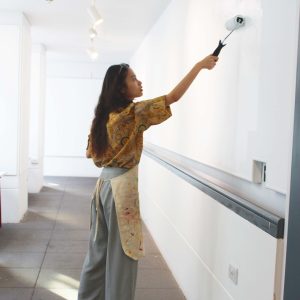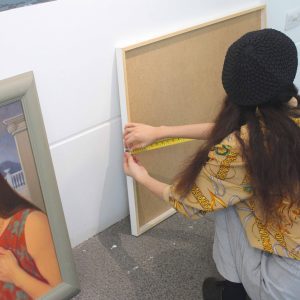‘Behind the Scenes’ with our Placement Students
In July, Attenborough Arts Centre welcomed two new placement students, Xiaoya and Chloe, from the University of Leicester’s School of Museum Studies. To find out more about what they’ve been up to on their placements we’re taking a ‘behind the scenes’ look at an upcoming exhibition they’ve been involved with.
On 6 September a new art exhibition called ‘Emotional Capsule: Women’s Invisible Emotion’ will be launching in the Balcony Gallery. This exhibition has been curated by Xiaoya using the University of Leicester’s Art Collection to explore themes of gender diversity and representations of women in the Visual Arts. Chloe has been working to develop and deliver a marketing plan for this exhibition drawing on her experience so far of working with the Marketing team. In preparation for the launch, Xiaoya and Chloe have shared their experiences of working on the project.
What were the different processes involved in curating this exhibition?
Xiaoya: “I was assigned to design a temporary exhibition in the Balcony Gallery, showcasing art pieces from the collection of the University of Leicester. The processes involved in curation with following points:
- Select possible collections: In the initial stage, I had to select around twenty art pieces from over 1500 items in the school’s art collection database and organize them around a central theme for the exhibition. However, the information in the database was incomplete, lacking artwork images and precise locations for part of the art pieces. This necessitated on-site inspections throughout the campus buildings and visits to the Putney Art Store on campus to view the artworks.
- Updating the Collection Database and recovering lost artworks: Through my previous efforts, the information in the university’s collection database concerning the existing artworks’ images and locations has been corrected and updated. In addition, I successfully retrieved some of the lost artworks, returning them to the university’s art storage.
- Exhibition Theme Planning: Based on the artwork I chose, I curated and focused on reflecting women’s lives and emotions.”
How did you come to choose this as your exhibition theme?
Xiaoya: “I mainly review what was lacking in the theme of Attenborough Art Centre’s previous exhibitions at the Balcony Gallery. As well as utilizing previously unshown collections with the idea of making the most out of the art in the collection storage room.
This thematic approach shed light on the gender imbalance within the collection. Among over 1500 artworks, only 30 were related to women, revealing an uneven representation and visibility of female-related themes. By showcasing an exhibition centred on female emotions, I intend to bring attention to the issue of gender disparity in the university’s art collection. This can enrich the university’s future choices in art acquisitions and make Attenborough Arts Centre more inclusive in advocating gender equality, aligning with their institutional vision: “Breaking down barriers to the arts, we are inclusive, radical, and ambitious. Bold in our creativity & action, we are Citizens of Change.”

What did the marketing process for this exhibition look like?
Chloe: “For me, a really important part of the process for marketing this exhibition was research.
I was initially tasked with identifying several target audience groups for this exhibition. To do so, I conducted research into visual arts audiences more broadly including existing audiences at Attenborough Arts Centre, as well as those which are often underrepresented in the arts. Based on my findings I was then able to conduct further research using online resources and different kinds of data to develop a better understanding of how these audiences might prefer to engage with the visual arts and identify marketing methods which might help to facilitate this engagement. Having all of this information meant that I was able to make informed decisions about the kinds of marketing materials I should produce, as well as the design of visual assets and the style and content of any copy. Once I’d done this, it was just a case of designing the assets and writing the copy!”
Are there any practical skills have you both learned during this project? And if so, how might they be of use to you in future work?
Xiaoya: “1. Practical exercise of examining artworks in the exhibition preparation room and filling out a report on the condition of the artworks. I was taught how to do artwork condition inspections in the course, but I lacked practical experience in the real world. This practical exercise has helped me to become more skilful in dealing with this type of work. 2. Gain an in-depth understanding of the overall workflow of exhibition planning and have the ability to cope with tricky situations. The cases presented in class are usually based on curatorial steps under idealized conditions, but tricky situations can be encountered in real work. Through this internship, I aim to gain a comprehensive understanding of every aspect of exhibition planning, from preparation to execution. By focusing on pretty hands-on work, I have learnt in profession in exhibition-making process.”
Chloe: “Because I settled on creating a mix of both physical and digital marketing materials, I was able to develop my skills in a number of areas including graphic design, report writing, and even learning how to write copy for different audiences on different digital platforms (including for this news post!). I have also spent a lot of time reading and learning about accessible marketing practices which I will be carrying forwards into all of the future work I do.”

What has your favourite aspect of this experience been?
Xiaoya: “The process of building an idea from scratch is the most enjoyable for me. Writing and output are my favourite parts of the process, especially when it comes to figuring out how to interpret the artwork.”
Chloe: “Working with the Marketing Team at Attenborough Arts Centre throughout my placement has been a hugely valuable experience which I am really grateful for! I think learning about and approaching marketing from an ‘audience centred’ perspective has been my favourite part of the experience. Seeing how marketing and outreach can be used to help identify and breakdown unintentional barriers to the arts by developing an understanding of the circumstances, needs, and expectations of different audiences has been really interesting and inspiring.”
What will you take away from this project?
Xiaoya: “I aim to gain a comprehensive understanding of every aspect of exhibition planning, from preparation to execution. My Attenborough Arts Centre placement has been an enriching experience, and I am grateful for the opportunities it provided to contribute to the institution’s vision while also aligning with my own future career goals in the arts sector. The experience has deepened my passion for curatorial work, and I am excited to continue pursuing a career that fosters inclusivity, creativity, and positive change through the arts.”
Chloe: “Along with the different practical marketing skills I’ve learnt, I think one of the biggest things I will take away from this project and my placement as a whole is the ‘audience centred’ approach to arts marketing. I’m excited to see how audience centred marketing practices could help in addressing and removing some of the barriers to arts engagement and hopefully inspire positive change throughout the sector!”
‘Emotional Capsule: Women’s Invisible Emotions’ launches on 6 September and will be open weekdays from 9am – 5pm and from 10am – 5pm on weekends.
For more information about the exhibition, visit our webpage.
